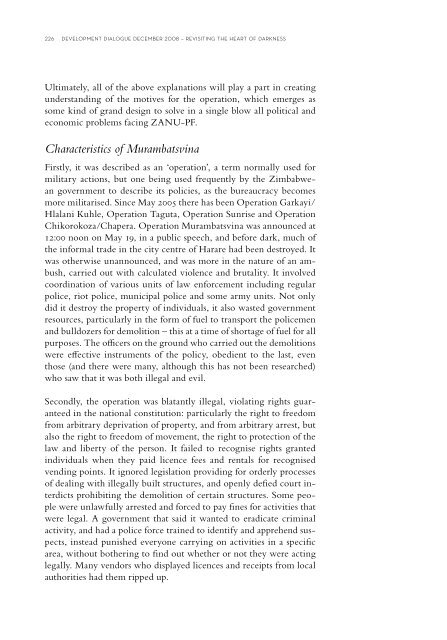60 years after the UN Convention - Dag Hammarskjöld Foundation
60 years after the UN Convention - Dag Hammarskjöld Foundation
60 years after the UN Convention - Dag Hammarskjöld Foundation
Create successful ePaper yourself
Turn your PDF publications into a flip-book with our unique Google optimized e-Paper software.
226 development dialogue december 2008 – revisiting <strong>the</strong> heart of darkness<br />
Ultimately, all of <strong>the</strong> above explanations will play a part in creating<br />
understanding of <strong>the</strong> motives for <strong>the</strong> operation, which emerges as<br />
some kind of grand design to solve in a single blow all political and<br />
economic problems facing ZANU-PF.<br />
Characteristics of Murambatsvina<br />
Firstly, it was described as an ‘operation’, a term normally used for<br />
military actions, but one being used frequently by <strong>the</strong> Zimbabwean<br />
government to describe its policies, as <strong>the</strong> bureaucracy becomes<br />
more militarised. Since May 2005 <strong>the</strong>re has been Operation Garkayi/<br />
Hlalani Kuhle, Operation Taguta, Operation Sunrise and Operation<br />
Chikorokoza/Chapera. Operation Murambatsvina was announced at<br />
12:00 noon on May 19, in a public speech, and before dark, much of<br />
<strong>the</strong> informal trade in <strong>the</strong> city centre of Harare had been destroyed. It<br />
was o<strong>the</strong>rwise unannounced, and was more in <strong>the</strong> nature of an ambush,<br />
carried out with calculated violence and brutality. It involved<br />
coordination of various units of law enforcement including regular<br />
police, riot police, municipal police and some army units. Not only<br />
did it destroy <strong>the</strong> property of individuals, it also wasted government<br />
resources, particularly in <strong>the</strong> form of fuel to transport <strong>the</strong> policemen<br />
and bulldozers for demolition – this at a time of shortage of fuel for all<br />
purposes. The offi cers on <strong>the</strong> ground who carried out <strong>the</strong> demolitions<br />
were eff ective instruments of <strong>the</strong> policy, obedient to <strong>the</strong> last, even<br />
those (and <strong>the</strong>re were many, although this has not been researched)<br />
who saw that it was both illegal and evil.<br />
Secondly, <strong>the</strong> operation was blatantly illegal, violating rights guaranteed<br />
in <strong>the</strong> national constitution: particularly <strong>the</strong> right to freedom<br />
from arbitrary deprivation of property, and from arbitrary arrest, but<br />
also <strong>the</strong> right to freedom of movement, <strong>the</strong> right to protection of <strong>the</strong><br />
law and liberty of <strong>the</strong> person. It failed to recognise rights granted<br />
individuals when <strong>the</strong>y paid licence fees and rentals for recognised<br />
vending points. It ignored legislation providing for orderly processes<br />
of dealing with illegally built structures, and openly defi ed court interdicts<br />
prohibiting <strong>the</strong> demolition of certain structures. Some people<br />
were unlawfully arrested and forced to pay fi nes for activities that<br />
were legal. A government that said it wanted to eradicate criminal<br />
activity, and had a police force trained to identify and apprehend suspects,<br />
instead punished everyone carrying on activities in a specifi c<br />
area, without bo<strong>the</strong>ring to fi nd out whe<strong>the</strong>r or not <strong>the</strong>y were acting<br />
legally. Many vendors who displayed licences and receipts from local<br />
authorities had <strong>the</strong>m ripped up.

















